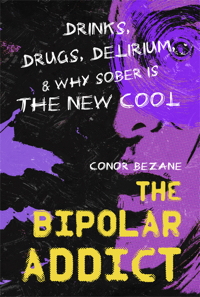Jimi Hendrix is a touchstone in American culture. To say he is a rock icon is an understatement. Hendrix transcends rock ‘n’ roll.
His “Star Spangled Banner” at Woodstock ‘69 was a furious culmination of feedback and distortion, an allegory for the tumultuous state of the world as the Vietnam War raged and the Civil Rights Movement reached a fever pitch with the assassination of Martin Luther King, Jr., just one year prior.
Hendrix is the greatest guitarist of all time. Hyperbolic, but true. Just ask Rolling Stone. On songs like “Purple Haze” and “Voodoo Chile,” his fingers glide up and down the neck of his guitar like there’s melted butter on the strings. Hendrix was a self-taught, left-handed guitarist whose hot-headed solos howl and wail with melody and ferocity.
It’s unclear whether or not Hendrix was bipolar, but he wrote a song about it. Track two of his debut album, Are You Experienced, is called “Manic Depression”:
Music, sweet music
I wish I could caress
Manic depression’s
A frustrated mess
Hendrix exhibited signs of manic depression, but as far as we know, he was never diagnosed. Or he kept it a secret.
However, Hendrix did have a serious problem with drugs and alcohol.
From marijuana to LSD to amphetamines to cocaine, Hendrix was an avid abuser of illegal drugs.
“People tell me I get foolish, good-natured sometimes [when I’m drunk],” he told biographers Steven Roby and Brad Schreiber.
In the summer of 1962, after Hendrix was discharged from the army, he went to a bar with $400 he had saved up. “I guess I felt real benevolent that day,” he told Roby and Schreiber. “I must have been handing out bills to anyone that asked me. I came out of that place with sixteen dollars left.”
But that was a rare moment of intoxicated generosity. Hendrix was notorious for violent rage when he was drunk, high — or both.
“Alcohol would later be the scourge of his existence,” the same biographers wrote. “Driving him to fits of pique, even rare bursts of atypical, physical violence.”
In January 1968, The Jimi Hendrix Experience traveled to Sweden for a short European tour. At a Gothenburg hotel, Hendrix got into a drunken brawl and smashed his right hand through a window, requiring medical attention. He was arrested and expunged after paying a big fine.
“You wouldn’t expect somebody with that kind of love to be that violent,” his friend Herbie Worthington said in the book Room Full of Mirrors: A Biography of Jimi Hendrix. “He just couldn’t drink… he simply turned into a bastard.”
In 1969, Hendrix was renting a house in Benedict Canyon, California. After the house was burglarized, Hendrix accused his friend Paul Caruso of ripping him off, punching him in the nose in a high, drunken stupor. He chased Caruso away from the house while throwing stones at him.
A few days later, Hendrix got into an argument with one of his girlfriends, Carmen Borrero, and hit her with a vodka bottle, inflicting an injury that required stitches, according to Cross’ biography.
And then there was the notorious Canadian drug trial.
A 1970 article in Rolling Stone reports an incident in Canada in which Hendrix was found not guilty for possession of heroin and hash, which was found in his carry-on bag in Toronto in May 1969.
His “Oh no, I really don’t know what it is. Someone must have put it in my bag” defense worked. Living the rock ‘n’ roll lifestyle, fans bestow gifts upon you, and that was his excuse. The jury at the Toronto Supreme Court bought it.
Hendrix also told the court: “I’ve outgrown [drugs].”
The details of Hendrix’s death are blurry at best. He died in London after staying up all night drinking red wine with girlfriend Monika Dannemann.
The two went to bed at 7AM, and Dannemann woke up around 11 to find Hendrix breathing but unresponsive. She called an ambulance, but he was pronounced dead on arrival at St. Mary Abbot’s Hospital on Sept. 18, 1970, at age 27. The coroner reported that Hendrix had choked on his own vomit in his sleep, asphyxiated while under the influence of downers or, as they are chemically called, barbiturates.
During his short music career – his songbook with The Jimi Hendrix Experience only lasts four years and three albums – Hendrix changed what it means to play the electric guitar. For this piece, I listened back to those three albums — I have them all on vinyl — and, I have to say, Hendrix really accelerated the instrument to whole new levels of virtuosity. While it’s unfortunate that he was a drunken, drugged-out jerk, his music speaks for itself. Like fellow son of Seattle Kurt Cobain, Hendrix was a transformative figure who belongs on page one of the annals of rock ‘n’ roll.








